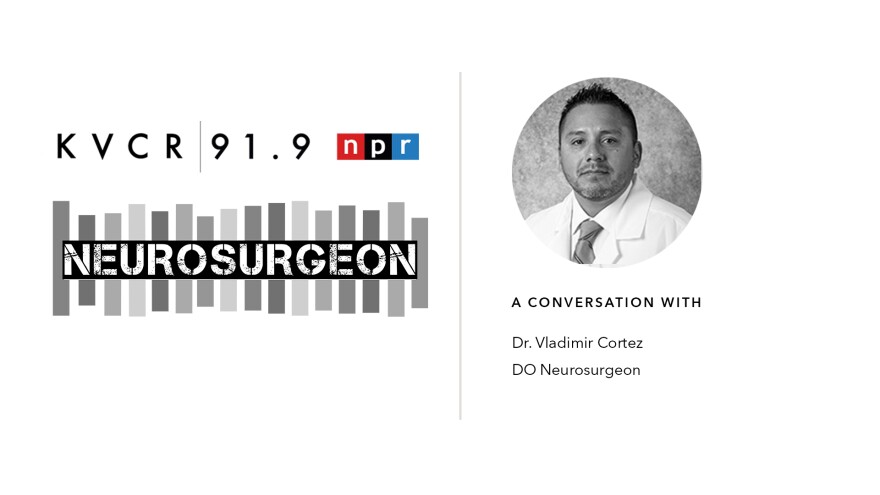Yvette Walker
With KVCR News, I'm Yvette Walker. This is IE Latino Voices, where we invite representatives from Latino led and Latino serving organizations to share their stories and their impact in our region. Joining me today is DO Neurosurgeon Dr. Vladimir Cortez. Thank you for being with us today, Dr Cortez.
Dr. Vladimir Cortez
Thank you, Yvette.
Yvette Walker
When did you first realize you wanted to become a physician?
Dr. Vladimir Cortez
Back in the mid 90s, after I left the military, I initially went to school to become an engineer, but I quickly learned that I liked it less than biology, so I started to go into biology, and from that, I proceeded to go into medical school.
Yvette Walker
Dr. Cortez, what area of practice do you focus on?
Dr. Vladimir Cortez
So I do general neurosurgery that includes brain and spine. So I do open brain surgery, open spinal surgery, but I also have a focus in endovascular. I did a two year fellowship where I treat the brain and the spine through a catheter for various vascular diseases of the brain and spine.
Yvette Walker
What are chronic subdural hematomas? And what are you seeing within the Latino community?
Dr. Vladimir Cortez
Chronic subdural hematomas are fluid collections that we can get in our brain from somewhat minor trauma. So there's two presentations of subdural hematomas - you can have acute, typically occurring in some form of major trauma, where the patient ends up in the hospital almost immediately, subacute or chronic hematomas. On the other hand, subdural hematomas are something that the patient develops over a period of time, usually a few weeks, sometimes can be a little bit longer, and the presentation is vastly different in comparison to an acute hematoma.
Yvette Walker
And what are some of the symptoms we should look out for?
Dr. Vladimir Cortez
So in this particular case, when the fluid is collecting on top of the or on the surface of the brain. What's happening is the patient initially may or may not necessarily fail symptoms, but when they do, they typically present with weakness depending on the side of the hematoma. So if it's on the right side, they're likely to have perhaps some numbness or weakness of the left arm, left leg, if it's on the left side, just opposite. But the left side could potentially also include if fascia otherwise inability or having difficulty expressing their words. A lot of times, those patients present as if they're having a stroke. So they go into a hospital, the physician would immediately work up the patient and they believe they're having a stroke, they get a CAT scan, and that's where the CAT scan shows the fluid collection.
Yvette Walker
And what are the treatment options for those that present with symptoms of subdural hematomas?
Dr. Vladimir Cortez
There's a few. Sometimes they can be observed. It just depends on the size and the location of the subdural but they can be observed. Generally, all patients with subacute, chronic subdural hematomas are placed on a medication known as Keppra, which is a seizure medication, and that's prophylactic. So that goes across the board, when a patient presents with a large fluid collection that is causing symptoms, the traditional treatment is to go in and do what's called a burr hole, to go in and literally make a small incision, generally about a couple inches long, and go in with a perforator, create a small bone window and get into beyond the dura where the fluid is being held and allow the fluid to come out, typically for one versus two holes, wash it out. And that usually works, but it does have a tendency to return at least a 10 to 15% of patients. And so with the years of research, what we end up noticing and determining is that when the patients are having recurrence of the fluid is because the door itself has somehow picked up blood flow into that area, causing the fluid to return. And so the other treatment option that can be done is called a middle meningeal artery embolization, otherwise commonly known as MMA. And the middle meningeal artery is the main blood supply to the dura. By embolizing the dura itself, in a sense, tends to shut off the blood supply to the subdural itself. So sometimes you can do a combination of both. In some patients, they can benefit from just the middle meningo artery embolization itself.
Yvette Walker
What's the best way to connect with you, Dr. Cortez?
Dr. Vladimir Cortez
In my personal office in Downtown Redlands, the clinic. Number is 909-283-4104, there's a person that is always there to receive phone calls if the patient is having symptoms, most likely, we're going to direct them to go to the hospital to get checked immediately, because the concern is, are the symptoms causing the patient to have weakness, because that can also potentially be seizure like activity.
Yvette Walker
Thank you so much for sharing your time with us today, Dr. Cortez. Thank you join us again next week for IE Latino Voices. You can find this story and others on our website at KVCRnews.org/IELatinoVoices. IE Latino Voices is produced by KVCR Public Media and is funded by generous support from San Antonio Regional Hospital. Here for life. For KVCR News, I'm Yvette Walker.







